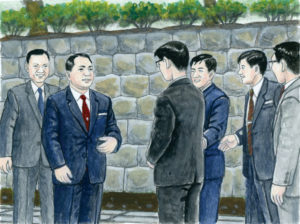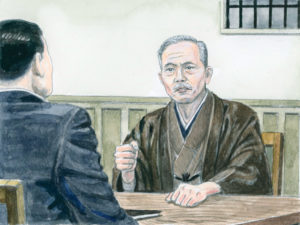This installment, published in the November 17, 2020, issue of the Seikyo Shimbun, focuses on passages from Nichiren Daishonin’s writings that SGI President Ikeda discussed in volume 16 of The New Human Revolution.
Passage 1
“The cherry, the plum, the peach, the damson—in its own entity, without undergoing any change, possesses the eternally endowed three bodies.” (“The Record of the Orally Transmitted Teachings, p. 200)
Shine Our Brightest

Illustration courtesy of Seikyo Press.
On January 2, 1972, the first nationwide university group general meeting was held. Shin’ichi Yamamoto calls out to a group of university students who were gathered and encourages them.
“I can’t help but notice,” he added, “that while you seem to be gentle-natured, you are also somewhat fainthearted. Am I right?”
“Yes,” Mr. Yamaguchi replied in a soft voice.
Shin’ichi then said: “Unless we bring out the best sides of our character and inner tendencies, they can often become the cause of unhappiness. … ”
■ ■ ■
“Can we change our personality through faith?”
“Faith can enable us to counteract the negative aspects of our personality and bring out the positive aspects,” Shin’ichi replied. …
“Buddhism teaches the way that each of us, just as we are—in the same way that the cherry is a cherry, the plum is a plum, the peach is a peach and the damson is a damson—can realize happiness by bringing out the best of our innate disposition and potential. People who become angry quickly are passionate by nature, usually with a strong sense of truth and justice. If such people diligently strive in faith, they will no longer get angry about trivial things but be able to aim that emotion toward fighting against corruption and injustice.
“Those who are easily influenced by people around them have an inherent tendency to be kind to and get along well with others. Faith will help such people tap that gift. The process of doing so is called human revolution.” (The New Human Revolution, vol. 16, pp. 9–11)
Passage 2
“For example, the journey from Kamakura to Kyoto takes twelve days. If you travel for eleven but stop with only one day remaining, how can you admire the moon over the capital?” (“Letter to Niike,” The Writings of Nichiren Daishonin, vol. 1, p. 1027)
Striving for Kosen-rufu Throughout Our Lives

Illustration courtesy of Seikyo Press.
In January 1972, Shin’ichi encourages an older women’s division member in Koza, Okinawa (part of present-day Okinawa city), at a commemorative photo session.
“We never graduate or retire from faith. Indeed, to live is to keep on striving.”
Coming into contact with the elderly members of Okinawa, who were all steadfastly carrying out their Buddhist practice despite their advanced age, caused Shin’ichi Yamamoto’s fighting spirit to burn even brighter.
He continued speaking to the woman in front of him: “Older people have great strength. Their tremendous life experience gives them a fundamental wisdom about living. They also have an extensive network of friends and acquaintances. When such people make an earnest effort for kosen-rufu, they can demonstrate many times the ability of young people.”
■ ■ ■
Shin’ichi went on: “President Makiguchi, who was also advanced in age, carried on his struggle even in prison, asserting the truth of Nichiren Buddhism to the very end. I, too, am resolved to keep striving as long as I live, into my seventies and eighties. I will keep speaking, keep writing, keep calling out for justice. If I am no longer able to walk, I will still be able to write. And if I can’t use my hands, I’ll still be able to talk about Buddhism. I’ll still be able to chant to the Gohonzon and read Nichiren Daishonin’s writings.
“I will continue exerting myself until my last breath leaves my body, even if I have to crawl on all fours. That’s my determination. Please watch me. For that is the path of Buddhism and will represent the total victory of my life.” (NHR-16, 55–56)
The True Joy of Dialogue
British historian Arnold J. Toynbee’s book A Study of History attracted worldwide attention.
Its greatest feature was how Dr. Toynbee was able to understand history from the standpoint of “civilization,” transcending the conventional framework for the study of history based on “race” and “nation.” For his pioneering research, he is acknowledged as the most important historian of the 20th century.
The “Dialogue” chapter of volume 16 of The New Human Revolution details the discussions between Dr. Toynbee and Shin’ichi Yamamoto, which spanned a total of 40 hours over two years.
At the end of their discussion, Dr. Toynbee commented that “their discussions would enable him to reorganize his own thoughts” (The New Human Revolution, vol. 16, p. 153). The communion of a “Western historian” and an “Eastern Buddhist” brought a new “creation of wisdom.”
Inspired by one another, new ideas and discoveries are born. It’s by realizing this that we lead ourselves to new stages and find the true joy of dialogue.
According to Dr. Toynbee, history is not created by matters that are excellent material for newspaper headlines, but rather, history is ultimately created by the gentle movement at the river bottom.
Our dialogues, which aim for the prosperity of society through encouraging the human revolution of one person, is not a matter that will become a newspaper headline. However, it is the movement at the river bottom, which becomes the undercurrent of peace.
You are reading {{ meterCount }} of {{ meterMax }} free premium articles

